brake DODGE DURANGO 2011 3.G User Guide
[x] Cancel search | Manufacturer: DODGE, Model Year: 2011, Model line: DURANGO, Model: DODGE DURANGO 2011 3.GPages: 108, PDF Size: 5.96 MB
Page 5 of 108
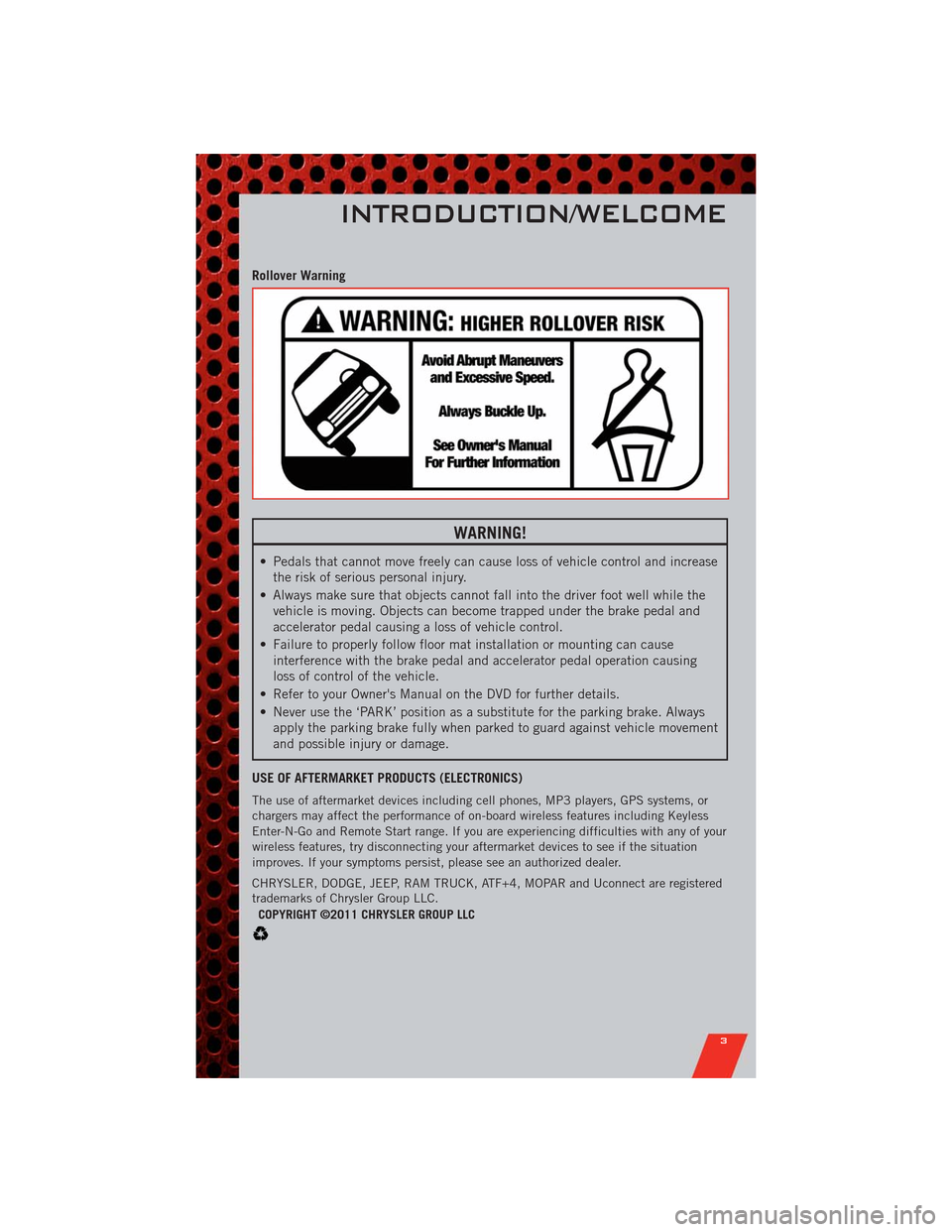
Rollover Warning
WARNING!
• Pedals that cannot move freely can cause loss of vehicle control and increase
the risk of serious personal injury.
• Always make sure that objects cannot fall into the driver foot well while the
vehicle is moving. Objects can become trapped under the brake pedal and
accelerator pedal causing a loss of vehicle control.
• Failure to properly follow floor mat installation or mounting can cause
interference with the brake pedal and accelerator pedal operation causing
loss of control of the vehicle.
• Refer to your Owner's Manual on the DVD for further details.
• Never use the ‘PARK’ position as a substitute for the parking brake. Always
apply the parking brake fully when parked to guard against vehicle movement
and possible injury or damage.
USE OF AFTERMARKET PRODUCTS (ELECTRONICS)
The use of aftermarket devices including cell phones, MP3 players, GPS systems, or
chargers may affect the performance of on-board wireless features including Keyless
Enter-N-Go and Remote Start range. If you are experiencing difficulties with any of your
wireless features, try disconnecting your aftermarket devices to see if the situation
improves. If your symptoms persist, please see an authorized dealer.
CHRYSLER, DODGE, JEEP, RAM TRUCK, ATF+4, MOPAR and Uconnect are registered
trademarks of Chrysler Group LLC.
COPYRIGHT ©2011 CHRYSLER GROUP LLC
INTRODUCTION/WELCOME
3
Page 8 of 108
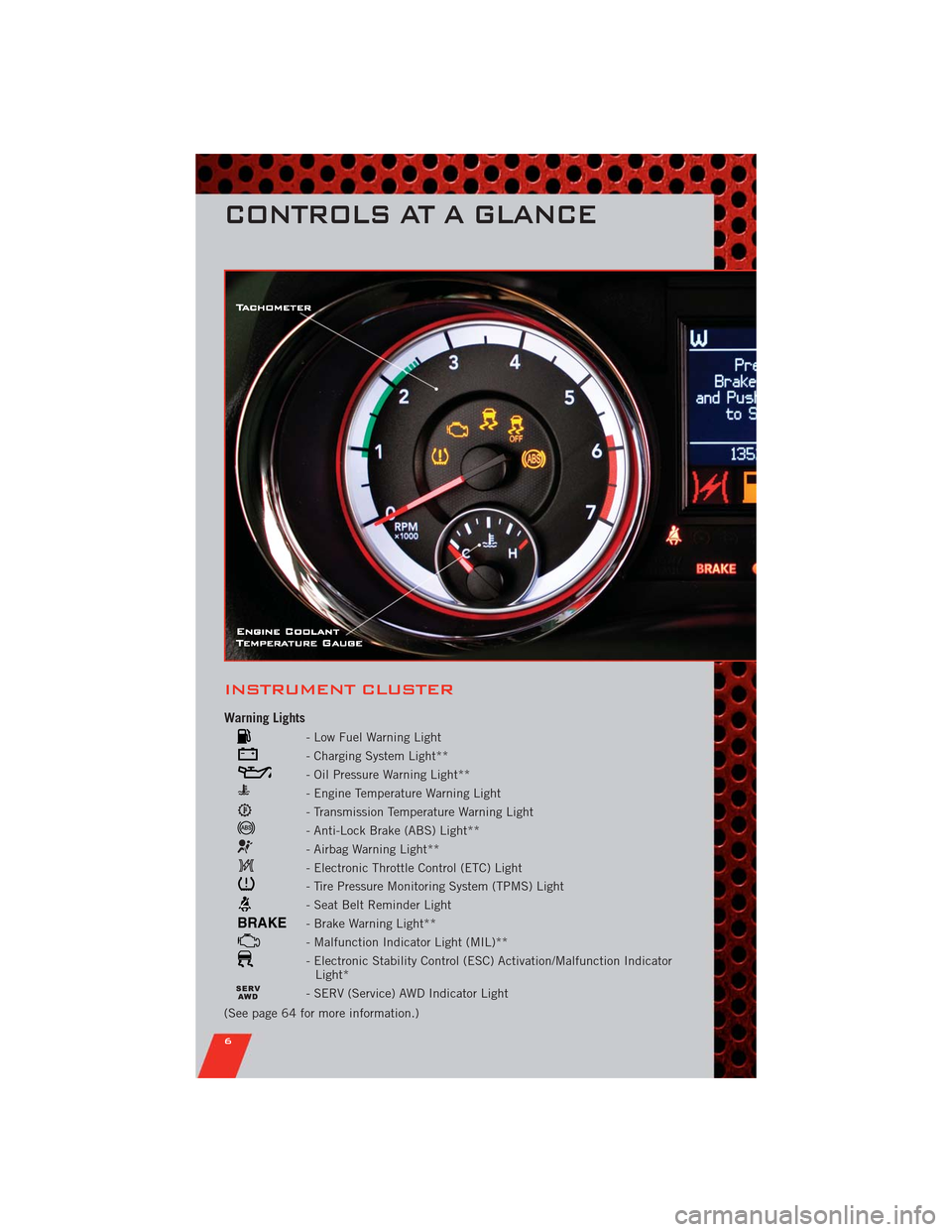
INSTRUMENT CLUSTER
Warning Lights
- Low Fuel Warning Light
- Charging System Light**
- Oil Pressure Warning Light**
- Engine Temperature Warning Light
- Transmission Temperature Warning Light
- Anti-Lock Brake (ABS) Light**
- Airbag Warning Light**
- Electronic Throttle Control (ETC) Light
- Tire Pressure Monitoring System (TPMS) Light
- Seat Belt Reminder Light
BRAKE- Brake Warning Light**
- Malfunction Indicator Light (MIL)**
- Electronic Stability Control (ESC) Activation/Malfunction Indicator
Light*
- SERV (Service) AWD Indicator Light
(See page 64 for more information.)
CONTROLS AT A GLANCE
6
Page 11 of 108
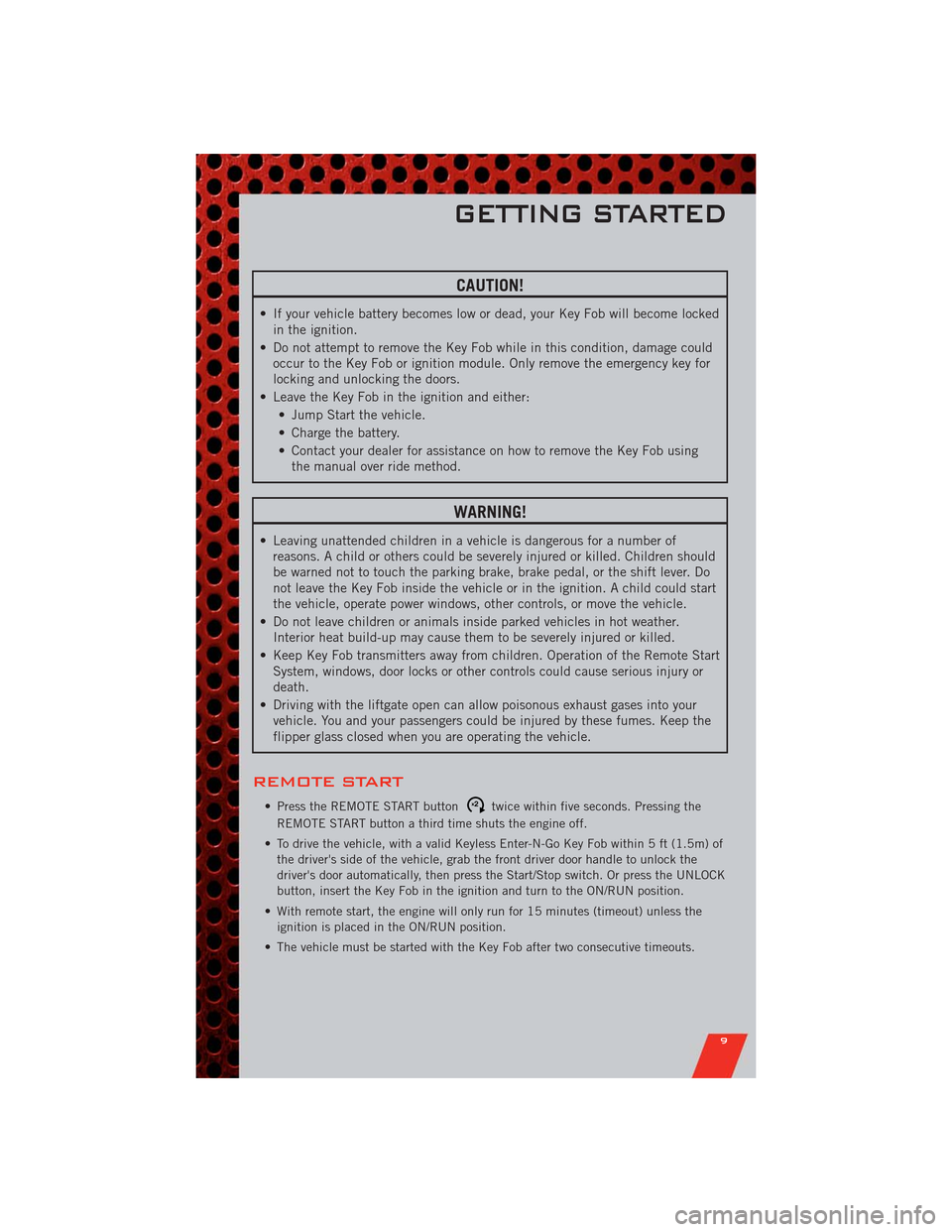
CAUTION!
• If your vehicle battery becomes low or dead, your Key Fob will become locked
in the ignition.
• Do not attempt to remove the Key Fob while in this condition, damage could
occur to the Key Fob or ignition module. Only remove the emergency key for
locking and unlocking the doors.
• Leave the Key Fob in the ignition and either:
• Jump Start the vehicle.
• Charge the battery.
• Contact your dealer for assistance on how to remove the Key Fob using
the manual over ride method.
WARNING!
• Leaving unattended children in a vehicle is dangerous for a number of
reasons. A child or others could be severely injured or killed. Children should
be warned not to touch the parking brake, brake pedal, or the shift lever. Do
not leave the Key Fob inside the vehicle or in the ignition. A child could start
the vehicle, operate power windows, other controls, or move the vehicle.
• Do not leave children or animals inside parked vehicles in hot weather.
Interior heat build-up may cause them to be severely injured or killed.
• Keep Key Fob transmitters away from children. Operation of the Remote Start
System, windows, door locks or other controls could cause serious injury or
death.
• Driving with the liftgate open can allow poisonous exhaust gases into your
vehicle. You and your passengers could be injured by these fumes. Keep the
flipper glass closed when you are operating the vehicle.
REMOTE START
• Press the REMOTE START buttonx2twice within five seconds. Pressing the
REMOTE START button a third time shuts the engine off.
• To drive the vehicle, with a valid Keyless Enter-N-Go Key Fob within 5 ft (1.5m) of
the driver's side of the vehicle, grab the front driver door handle to unlock the
driver's door automatically, then press the Start/Stop switch. Or press the UNLOCK
button, insert the Key Fob in the ignition and turn to the ON/RUN position.
• With remote start, the engine will only run for 15 minutes (timeout) unless the
ignition is placed in the ON/RUN position.
• The vehicle must be started with the Key Fob after two consecutive timeouts.
GETTING STARTED
9
Page 13 of 108
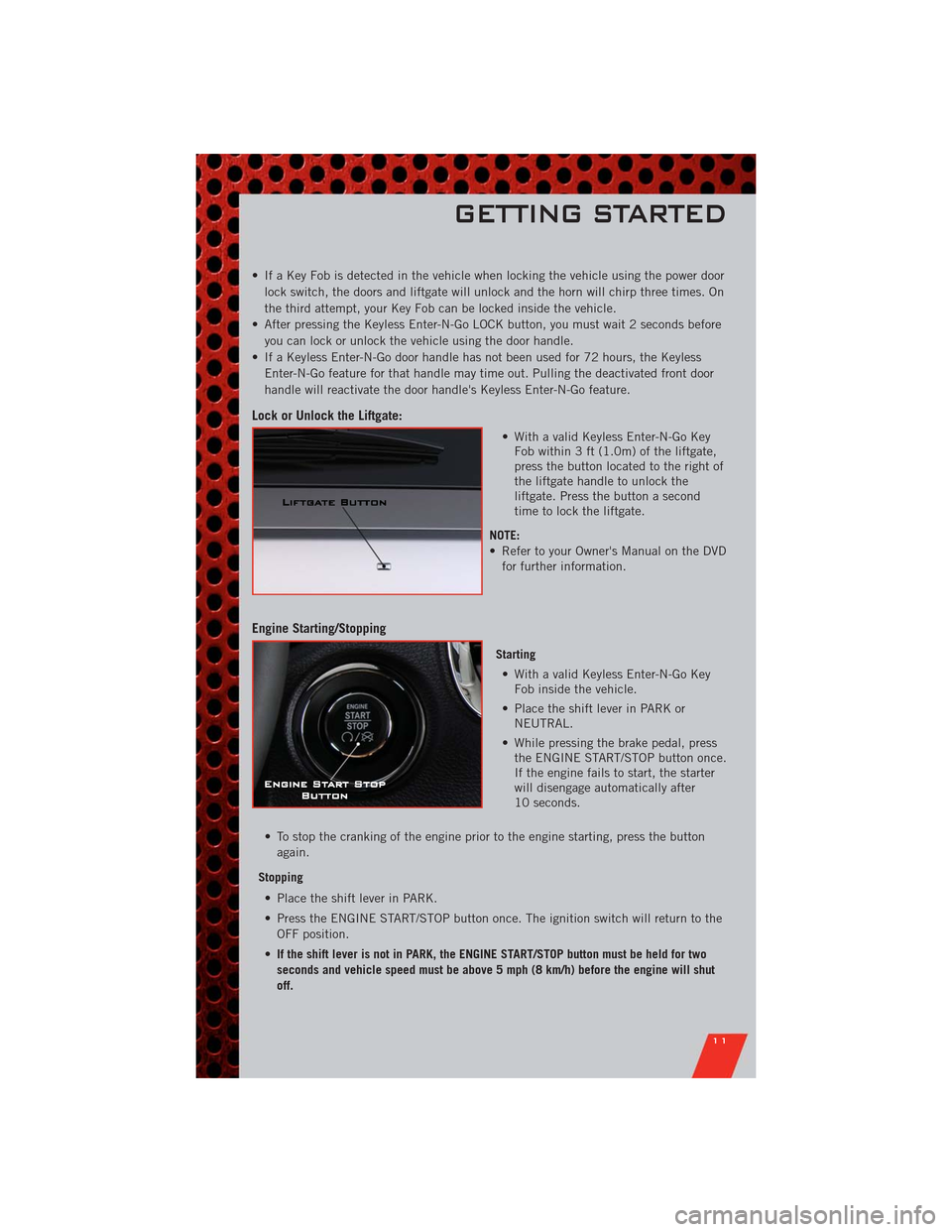
• If a Key Fob is detected in the vehicle when locking the vehicle using the power door
lock switch, the doors and liftgate will unlock and the horn will chirp three times. On
the third attempt, your Key Fob can be locked inside the vehicle.
• After pressing the Keyless Enter-N-Go LOCK button, you must wait 2 seconds before
you can lock or unlock the vehicle using the door handle.
• If a Keyless Enter-N-Go door handle has not been used for 72 hours, the Keyless
Enter-N-Go feature for that handle may time out. Pulling the deactivated front door
handle will reactivate the door handle's Keyless Enter-N-Go feature.
Lock or Unlock the Liftgate:
• With a valid Keyless Enter-N-Go Key
Fob within 3 ft (1.0m) of the liftgate,
press the button located to the right of
the liftgate handle to unlock the
liftgate. Press the button a second
time to lock the liftgate.
NOTE:
• Refer to your Owner's Manual on the DVD
for further information.
Engine Starting/Stopping
Starting
• With a valid Keyless Enter-N-Go Key
Fob inside the vehicle.
• Place the shift lever in PARK or
NEUTRAL.
• While pressing the brake pedal, press
the ENGINE START/STOP button once.
If the engine fails to start, the starter
will disengage automatically after
10 seconds.
• To stop the cranking of the engine prior to the engine starting, press the button
again.
Stopping
• Place the shift lever in PARK.
• Press the ENGINE START/STOP button once. The ignition switch will return to the
OFF position.
•If the shift lever is not in PARK, the ENGINE START/STOP button must be held for two
seconds and vehicle speed must be above 5 mph (8 km/h) before the engine will shut
off.
GETTING STARTED
11
Page 14 of 108
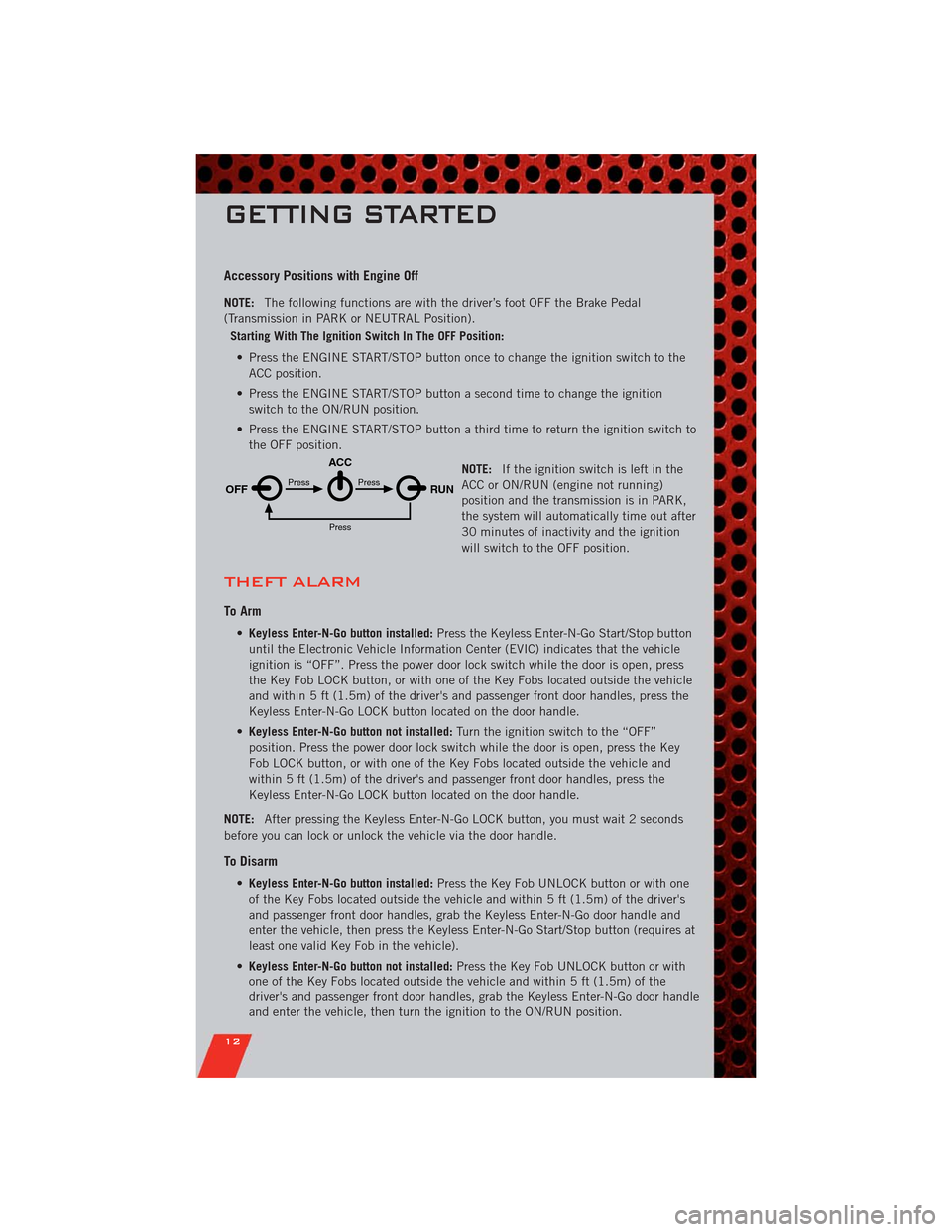
Accessory Positions with Engine Off
NOTE:The following functions are with the driver’s foot OFF the Brake Pedal
(Transmission in PARK or NEUTRAL Position).
Starting With The Ignition Switch In The OFF Position:
• Press the ENGINE START/STOP button once to change the ignition switch to the
ACC position.
• Press the ENGINE START/STOP button a second time to change the ignition
switch to the ON/RUN position.
• Press the ENGINE START/STOP button a third time to return the ignition switch to
the OFF position.
NOTE:If the ignition switch is left in the
ACC or ON/RUN (engine not running)
position and the transmission is in PARK,
the system will automatically time out after
30 minutes of inactivity and the ignition
will switch to the OFF position.
THEFT ALARM
To Arm
•Keyless Enter-N-Go button installed:Press the Keyless Enter-N-Go Start/Stop button
until the Electronic Vehicle Information Center (EVIC) indicates that the vehicle
ignition is “OFF”. Press the power door lock switch while the door is open, press
the Key Fob LOCK button, or with one of the Key Fobs located outside the vehicle
and within 5 ft (1.5m) of the driver's and passenger front door handles, press the
Keyless Enter-N-Go LOCK button located on the door handle.
•Keyless Enter-N-Go button not installed:Turn the ignition switch to the “OFF”
position. Press the power door lock switch while the door is open, press the Key
Fob LOCK button, or with one of the Key Fobs located outside the vehicle and
within 5 ft (1.5m) of the driver's and passenger front door handles, press the
Keyless Enter-N-Go LOCK button located on the door handle.
NOTE:After pressing the Keyless Enter-N-Go LOCK button, you must wait 2 seconds
before you can lock or unlock the vehicle via the door handle.
To Disarm
•Keyless Enter-N-Go button installed:Press the Key Fob UNLOCK button or with one
of the Key Fobs located outside the vehicle and within 5 ft (1.5m) of the driver's
and passenger front door handles, grab the Keyless Enter-N-Go door handle and
enter the vehicle, then press the Keyless Enter-N-Go Start/Stop button (requires at
least one valid Key Fob in the vehicle).
•Keyless Enter-N-Go button not installed:Press the Key Fob UNLOCK button or with
one of the Key Fobs located outside the vehicle and within 5 ft (1.5m) of the
driver's and passenger front door handles, grab the Keyless Enter-N-Go door handle
and enter the vehicle, then turn the ignition to the ON/RUN position.
OFF RUNACCPress Press
Press
GETTING STARTED
12
Page 29 of 108
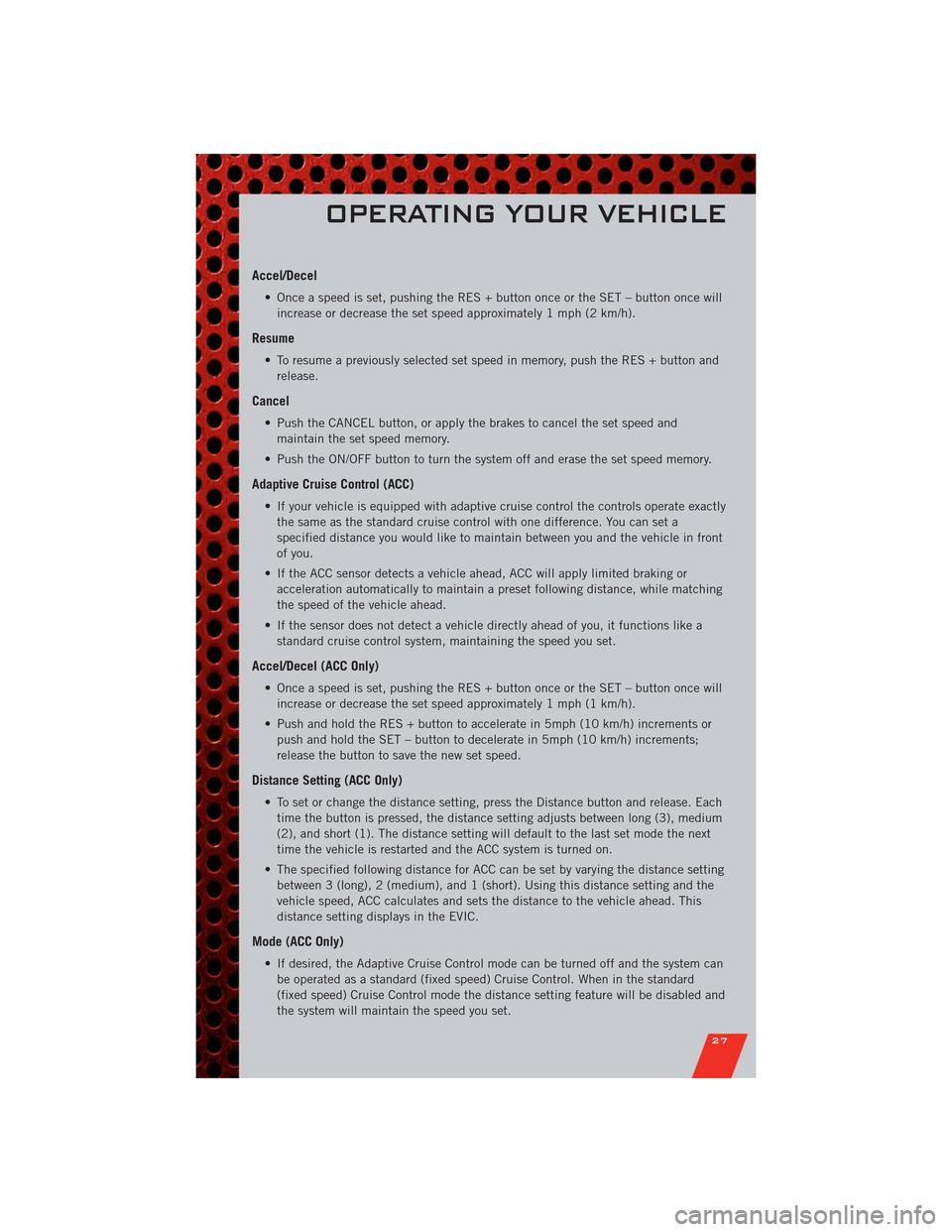
Accel/Decel
• Once a speed is set, pushing the RES + button once or the SET – button once will
increase or decrease the set speed approximately 1 mph (2 km/h).
Resume
• To resume a previously selected set speed in memory, push the RES + button and
release.
Cancel
• Push the CANCEL button, or apply the brakes to cancel the set speed and
maintain the set speed memory.
• Push the ON/OFF button to turn the system off and erase the set speed memory.
Adaptive Cruise Control (ACC)
• If your vehicle is equipped with adaptive cruise control the controls operate exactly
the same as the standard cruise control with one difference. You can set a
specified distance you would like to maintain between you and the vehicle in front
of you.
• If the ACC sensor detects a vehicle ahead, ACC will apply limited braking or
acceleration automatically to maintain a preset following distance, while matching
the speed of the vehicle ahead.
• If the sensor does not detect a vehicle directly ahead of you, it functions like a
standard cruise control system, maintaining the speed you set.
Accel/Decel (ACC Only)
• Once a speed is set, pushing the RES + button once or the SET – button once will
increase or decrease the set speed approximately 1 mph (1 km/h).
• Push and hold the RES + button to accelerate in 5mph (10 km/h) increments or
push and hold the SET – button to decelerate in 5mph (10 km/h) increments;
release the button to save the new set speed.
Distance Setting (ACC Only)
• To set or change the distance setting, press the Distance button and release. Each
time the button is pressed, the distance setting adjusts between long (3), medium
(2), and short (1). The distance setting will default to the last set mode the next
time the vehicle is restarted and the ACC system is turned on.
• The specified following distance for ACC can be set by varying the distance setting
between 3 (long), 2 (medium), and 1 (short). Using this distance setting and the
vehicle speed, ACC calculates and sets the distance to the vehicle ahead. This
distance setting displays in the EVIC.
Mode (ACC Only)
• If desired, the Adaptive Cruise Control mode can be turned off and the system can
be operated as a standard (fixed speed) Cruise Control. When in the standard
(fixed speed) Cruise Control mode the distance setting feature will be disabled and
the system will maintain the speed you set.
OPERATING YOUR VEHICLE
27
Page 30 of 108
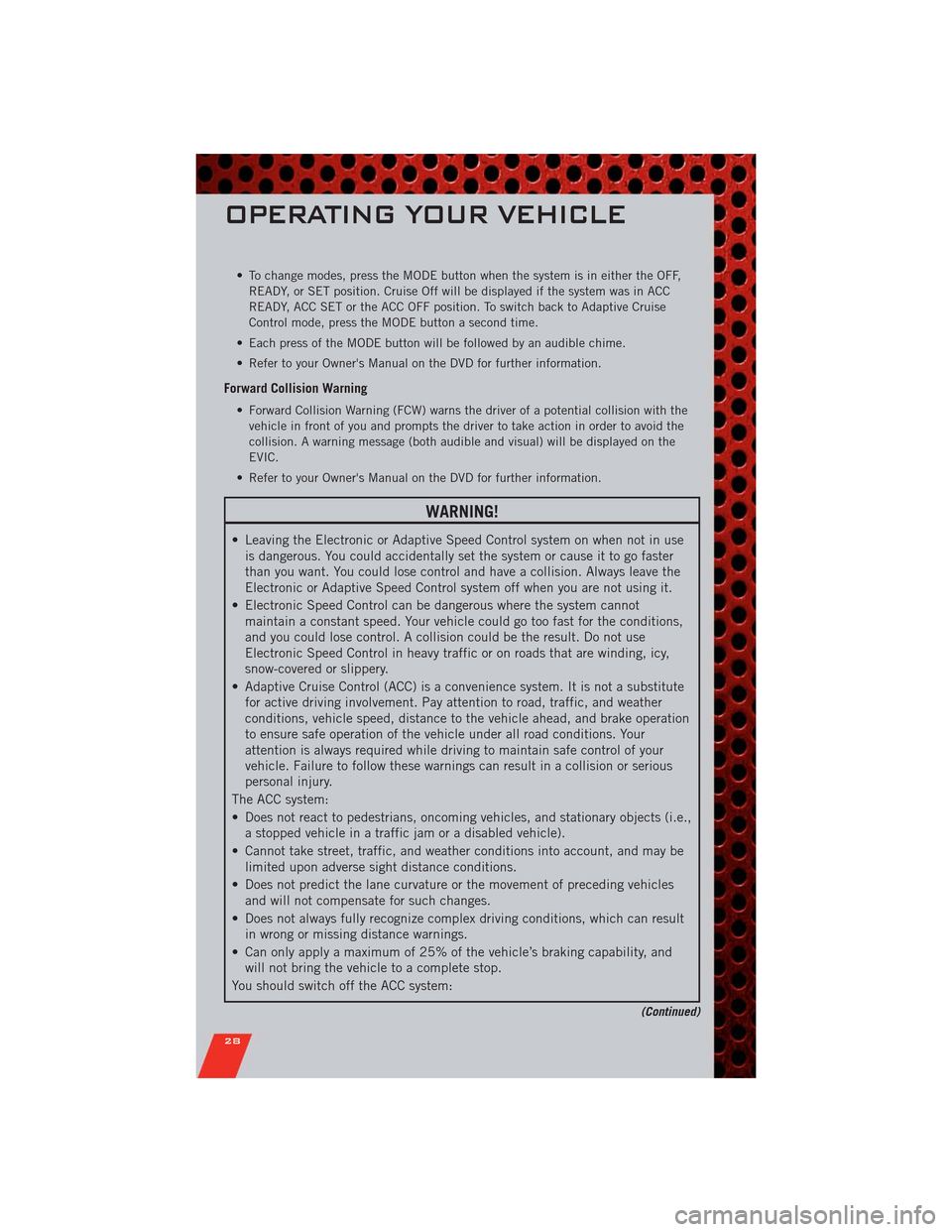
• To change modes, press the MODE button when the system is in either the OFF,
READY, or SET position. Cruise Off will be displayed if the system was in ACC
READY, ACC SET or the ACC OFF position. To switch back to Adaptive Cruise
Control mode, press the MODE button a second time.
• Each press of the MODE button will be followed by an audible chime.
• Refer to your Owner's Manual on the DVD for further information.
Forward Collision Warning
• Forward Collision Warning (FCW) warns the driver of a potential collision with the
vehicle in front of you and prompts the driver to take action in order to avoid the
collision. A warning message (both audible and visual) will be displayed on the
EVIC.
• Refer to your Owner's Manual on the DVD for further information.
WARNING!
• Leaving the Electronic or Adaptive Speed Control system on when not in use
is dangerous. You could accidentally set the system or cause it to go faster
than you want. You could lose control and have a collision. Always leave the
Electronic or Adaptive Speed Control system off when you are not using it.
• Electronic Speed Control can be dangerous where the system cannot
maintain a constant speed. Your vehicle could go too fast for the conditions,
and you could lose control. A collision could be the result. Do not use
Electronic Speed Control in heavy traffic or on roads that are winding, icy,
snow-covered or slippery.
• Adaptive Cruise Control (ACC) is a convenience system. It is not a substitute
for active driving involvement. Pay attention to road, traffic, and weather
conditions, vehicle speed, distance to the vehicle ahead, and brake operation
to ensure safe operation of the vehicle under all road conditions. Your
attention is always required while driving to maintain safe control of your
vehicle. Failure to follow these warnings can result in a collision or serious
personal injury.
The ACC system:
• Does not react to pedestrians, oncoming vehicles, and stationary objects (i.e.,
a stopped vehicle in a traffic jam or a disabled vehicle).
• Cannot take street, traffic, and weather conditions into account, and may be
limited upon adverse sight distance conditions.
• Does not predict the lane curvature or the movement of preceding vehicles
and will not compensate for such changes.
• Does not always fully recognize complex driving conditions, which can result
in wrong or missing distance warnings.
• Can only apply a maximum of 25% of the vehicle’s braking capability, and
will not bring the vehicle to a complete stop.
You should switch off the ACC system:
(Continued)
OPERATING YOUR VEHICLE
28
Page 60 of 108
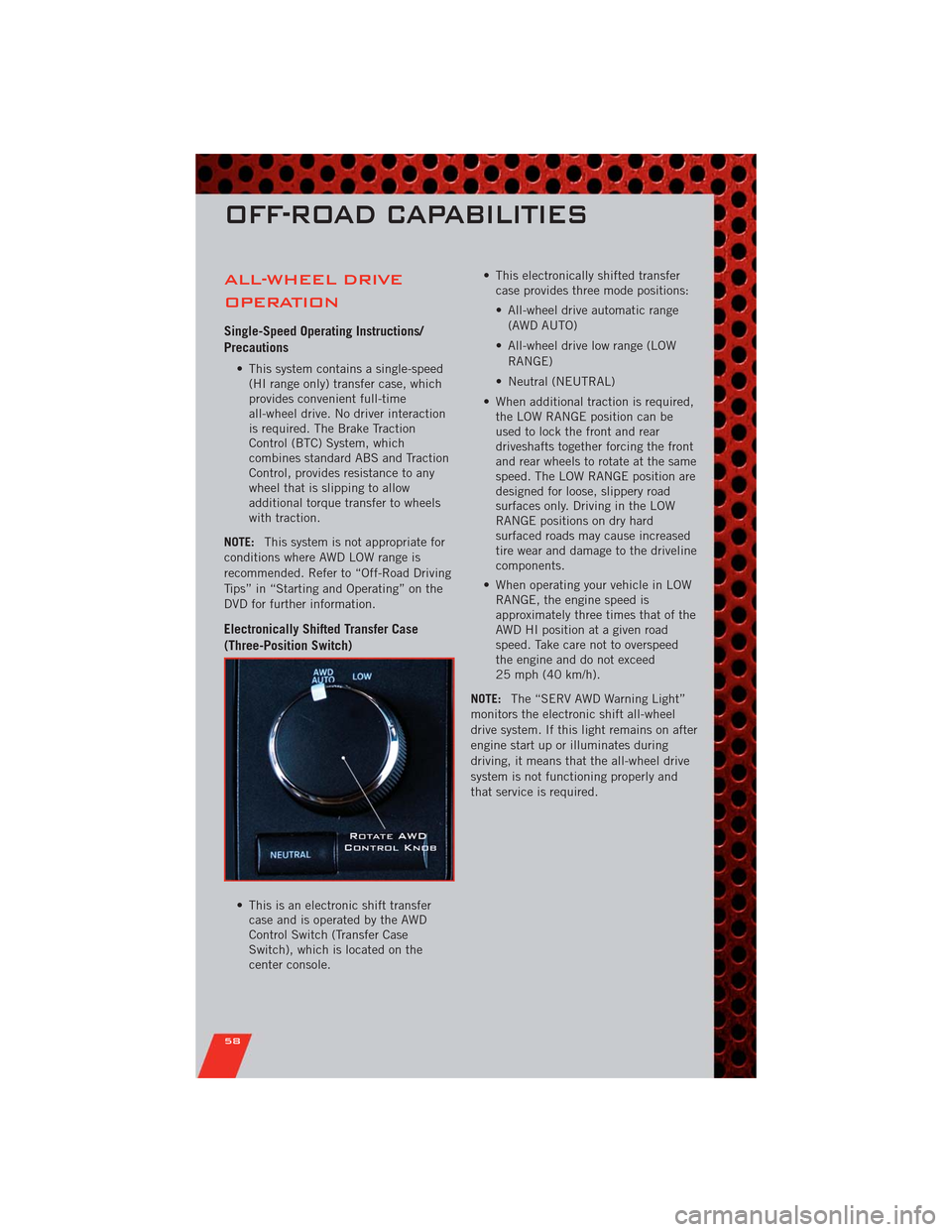
ALL-WHEEL DRIVE
OPERATION
Single-Speed Operating Instructions/
Precautions
• This system contains a single-speed
(HI range only) transfer case, which
provides convenient full-time
all-wheel drive. No driver interaction
is required. The Brake Traction
Control (BTC) System, which
combines standard ABS and Traction
Control, provides resistance to any
wheel that is slipping to allow
additional torque transfer to wheels
with traction.
NOTE:This system is not appropriate for
conditions where AWD LOW range is
recommended. Refer to “Off-Road Driving
Tips” in “Starting and Operating” on the
DVD for further information.
Electronically Shifted Transfer Case
(Three-Position Switch)
• This is an electronic shift transfer
case and is operated by the AWD
Control Switch (Transfer Case
Switch), which is located on the
center console.• This electronically shifted transfer
case provides three mode positions:
• All-wheel drive automatic range
(AWD AUTO)
• All-wheel drive low range (LOW
RANGE)
• Neutral (NEUTRAL)
• When additional traction is required,
the LOW RANGE position can be
used to lock the front and rear
driveshafts together forcing the front
and rear wheels to rotate at the same
speed. The LOW RANGE position are
designed for loose, slippery road
surfaces only. Driving in the LOW
RANGE positions on dry hard
surfaced roads may cause increased
tire wear and damage to the driveline
components.
• When operating your vehicle in LOW
RANGE, the engine speed is
approximately three times that of the
AWD HI position at a given road
speed. Take care not to overspeed
the engine and do not exceed
25 mph (40 km/h).
NOTE:The “SERV AWD Warning Light”
monitors the electronic shift all-wheel
drive system. If this light remains on after
engine start up or illuminates during
driving, it means that the all-wheel drive
system is not functioning properly and
that service is required.
OFF-ROAD CAPABILITIES
58
Page 61 of 108
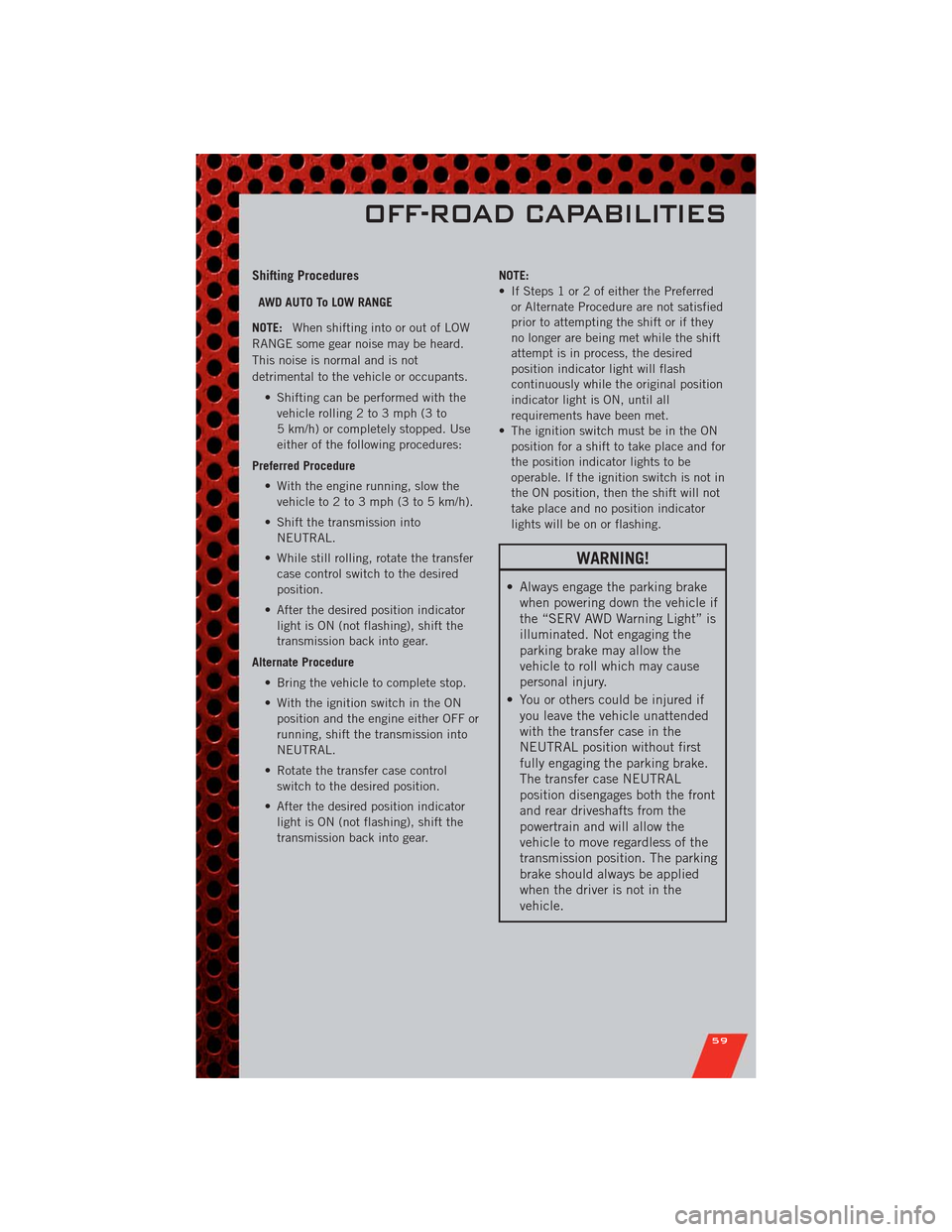
Shifting Procedures
AWD AUTO To LOW RANGE
NOTE:When shifting into or out of LOW
RANGE some gear noise may be heard.
This noise is normal and is not
detrimental to the vehicle or occupants.
• Shifting can be performed with the
vehicle rolling 2 to 3 mph (3 to
5 km/h) or completely stopped. Use
either of the following procedures:
Preferred Procedure
• With the engine running, slow the
vehicle to 2 to 3 mph (3 to 5 km/h).
• Shift the transmission into
NEUTRAL.
• While still rolling, rotate the transfer
case control switch to the desired
position.
• After the desired position indicator
light is ON (not flashing), shift the
transmission back into gear.
Alternate Procedure
• Bring the vehicle to complete stop.
• With the ignition switch in the ON
position and the engine either OFF or
running, shift the transmission into
NEUTRAL.
• Rotate the transfer case control
switch to the desired position.
• After the desired position indicator
light is ON (not flashing), shift the
transmission back into gear.NOTE:
• If Steps 1 or 2 of either the Preferred
or Alternate Procedure are not satisfied
prior to attempting the shift or if they
no longer are being met while the shift
attempt is in process, the desired
position indicator light will flash
continuously while the original position
indicator light is ON, until all
requirements have been met.
• The ignition switch must be in the ON
position for a shift to take place and for
the position indicator lights to be
operable. If the ignition switch is not in
the ON position, then the shift will not
take place and no position indicator
lights will be on or flashing.
WARNING!
• Always engage the parking brake
when powering down the vehicle if
the “SERV AWD Warning Light” is
illuminated. Not engaging the
parking brake may allow the
vehicle to roll which may cause
personal injury.
• You or others could be injured if
you leave the vehicle unattended
with the transfer case in the
NEUTRAL position without first
fully engaging the parking brake.
The transfer case NEUTRAL
position disengages both the front
and rear driveshafts from the
powertrain and will allow the
vehicle to move regardless of the
transmission position. The parking
brake should always be applied
when the driver is not in the
vehicle.
OFF-ROAD CAPABILITIES
59
Page 64 of 108
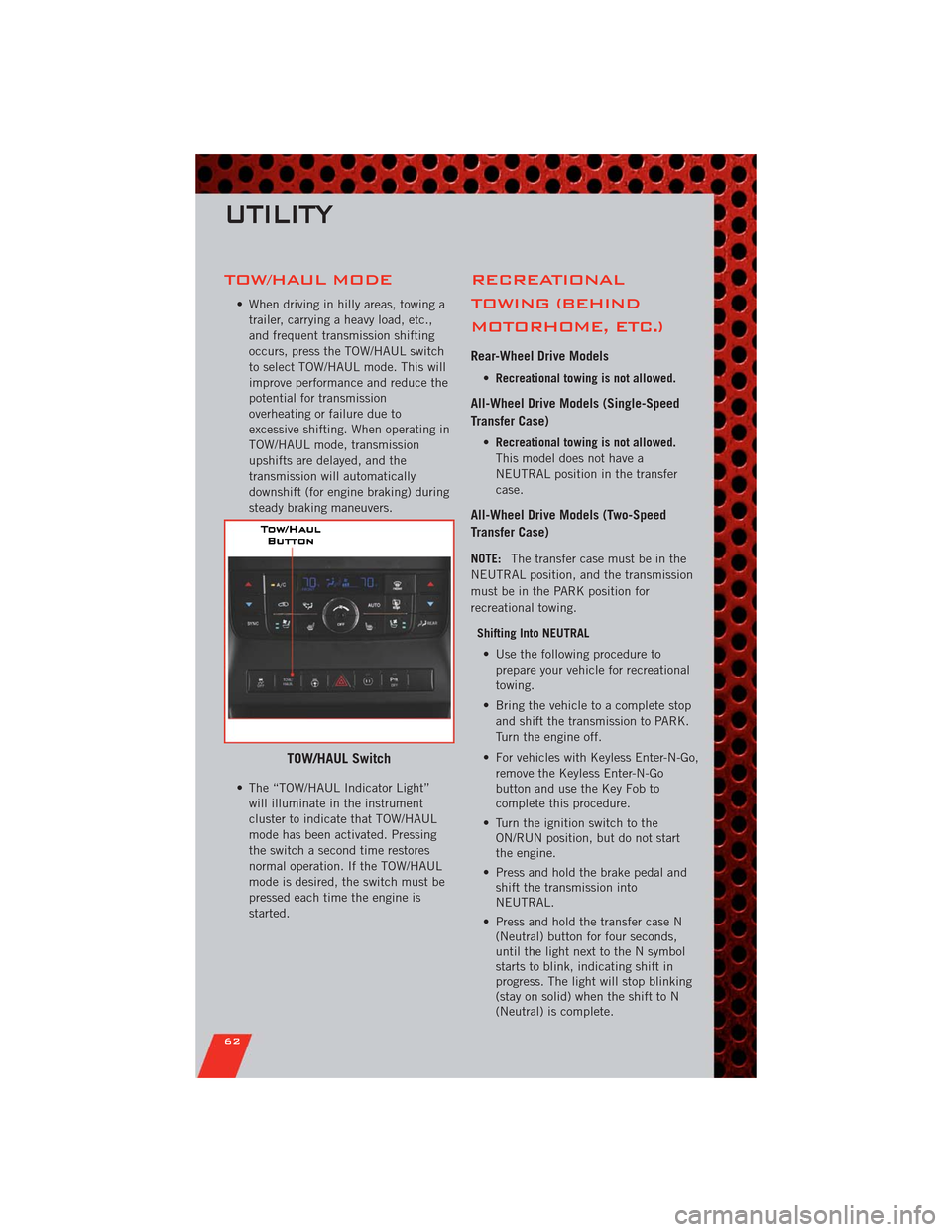
TOW/HAUL MODE
• When driving in hilly areas, towing a
trailer, carrying a heavy load, etc.,
and frequent transmission shifting
occurs, press the TOW/HAUL switch
to select TOW/HAUL mode. This will
improve performance and reduce the
potential for transmission
overheating or failure due to
excessive shifting. When operating in
TOW/HAUL mode, transmission
upshifts are delayed, and the
transmission will automatically
downshift (for engine braking) during
steady braking maneuvers.
• The “TOW/HAUL Indicator Light”
will illuminate in the instrument
cluster to indicate that TOW/HAUL
mode has been activated. Pressing
the switch a second time restores
normal operation. If the TOW/HAUL
mode is desired, the switch must be
pressed each time the engine is
started.
RECREATIONAL
TOWING (BEHIND
MOTORHOME, ETC.)
Rear-Wheel Drive Models
•Recreational towing is not allowed.
All-Wheel Drive Models (Single-Speed
Transfer Case)
•Recreational towing is not allowed.
This model does not have a
NEUTRAL position in the transfer
case.
All-Wheel Drive Models (Two-Speed
Transfer Case)
NOTE:The transfer case must be in the
NEUTRAL position, and the transmission
must be in the PARK position for
recreational towing.
Shifting Into NEUTRAL
• Use the following procedure to
prepare your vehicle for recreational
towing.
• Bring the vehicle to a complete stop
and shift the transmission to PARK.
Turn the engine off.
• For vehicles with Keyless Enter-N-Go,
remove the Keyless Enter-N-Go
button and use the Key Fob to
complete this procedure.
• Turn the ignition switch to the
ON/RUN position, but do not start
the engine.
• Press and hold the brake pedal and
shift the transmission into
NEUTRAL.
• Press and hold the transfer case N
(Neutral) button for four seconds,
until the light next to the N symbol
starts to blink, indicating shift in
progress. The light will stop blinking
(stay on solid) when the shift to N
(Neutral) is complete.
TOW/HAUL Switch
UTILITY
62